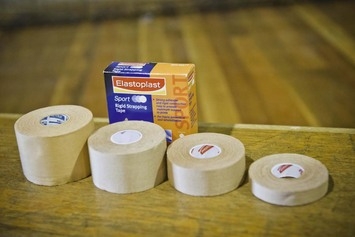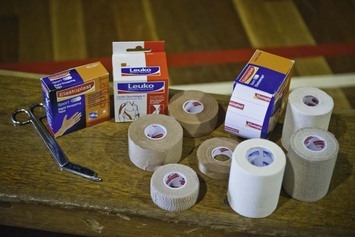Chapter Ten Sports taping
1. List contraindications and precautions for taping.
2. Demonstrate effective preventive taping of an ankle.
3. Demonstrate effective preventive taping of a thumb.
4. Demonstrate effective taping of fingers.
5. Demonstrate the safe removal of tape from an athlete.
6. For Level 2 Sports Trainers, demonstrate the application of effective preventive taping of the knee and shoulder.
Assessment of outcomes
Materials
Associated materials that may assist taping
Elastic under-wrap
To enhance the effectiveness of taping over under-wrap:
 the area must be free of body hair
the area must be free of body hair
 if gauze pads are to be used, apply them as described in the section below.
if gauze pads are to be used, apply them as described in the section below.
Using under-wrap can reduce the effectiveness of the taping.
Using adhesive tape for sports injuries
When using adhesive tape for sports injuries, the main considerations for sports trainers are:
 appropriate positioning of the athlete for the body area to be taped
appropriate positioning of the athlete for the body area to be taped
 the proper application and method of taping
the proper application and method of taping
 post-taping checks and warning the athlete regarding precautions
post-taping checks and warning the athlete regarding precautions
Preparation for taping
 the application area is clean and dry with no dirt, oil or lotions
the application area is clean and dry with no dirt, oil or lotions
 hair has been removed from the application area at least 12 hours prior to taping if possible
hair has been removed from the application area at least 12 hours prior to taping if possible
 padding has been applied to areas that require protection
padding has been applied to areas that require protection
 tape is only applied when the application area is at normal body temperature
tape is only applied when the application area is at normal body temperature
 a tape adhesive is applied if additional adhesion is required
a tape adhesive is applied if additional adhesion is required
 under-wrap is applied if the athlete is allergic or sensitive to the adhesive on the tape
under-wrap is applied if the athlete is allergic or sensitive to the adhesive on the tape
 the area is free of body hair when applying under-wrap and tape adhesive is used prior to applying it.
the area is free of body hair when applying under-wrap and tape adhesive is used prior to applying it.
Proper application and method of taping
 Select appropriate sized tape for the area and for the degree of restriction of movement required.
Select appropriate sized tape for the area and for the degree of restriction of movement required.
 Place the joint in the appropriate position to achieve your objective.
Place the joint in the appropriate position to achieve your objective.
 If taping over a muscle, allow for contraction and expansion of the area.
If taping over a muscle, allow for contraction and expansion of the area.
 Avoid continuous taping. Make one circle at a time to prevent constriction.
Avoid continuous taping. Make one circle at a time to prevent constriction.
 Overlap the tape by a half to a third of the width of the tape below.
Overlap the tape by a half to a third of the width of the tape below.
 Tape from the roll whenever possible. Tape laid from the roll will conform to the area better and your speed, proficiency and efficiency will be improved.
Tape from the roll whenever possible. Tape laid from the roll will conform to the area better and your speed, proficiency and efficiency will be improved.
 When taping from the roll, ensure the tape is laid on and smoothed out and not pulled too tightly.
When taping from the roll, ensure the tape is laid on and smoothed out and not pulled too tightly.
 Allow the tape to fit the contours of the area. Rigid tape will not bend around acute angles. Do not allow wrinkles or gaps as they will irritate or cut the skin.
Allow the tape to fit the contours of the area. Rigid tape will not bend around acute angles. Do not allow wrinkles or gaps as they will irritate or cut the skin.
 Start taping with an ‘anchor’ piece. The anchor provides a stable base for the strips that follow.
Start taping with an ‘anchor’ piece. The anchor provides a stable base for the strips that follow.
 Finish with a ‘lock’ piece. The lock ensures the supporting strips will not peel away during activity.
Finish with a ‘lock’ piece. The lock ensures the supporting strips will not peel away during activity.
Tearing adhesive tape
1. Hold the tape roll in the preferred hand with the index finger pressing its outer edge.
2. With the other hand, grasp the loose end between the thumb and the index finger.
3. With both hands in place, pull both ends of the tape so that it is tight.
4. Next, make a quick, scissor-like move to tear the tape. In tearing tape, the movement of one hand is away from the body and that of the other hand is towards the body. Do not try to twist or bend the tape in attempting to tear it.
Some people do not possess the strength or skill to tear tape effectively or the tape may be too rigid to tear manually. In this case, using a knife, scissors or razor blade may be warranted. Ensure such items are used with care around athletes to prevent unnecessary injury.
Stay updated, free articles. Join our Telegram channel

Full access? Get Clinical Tree























